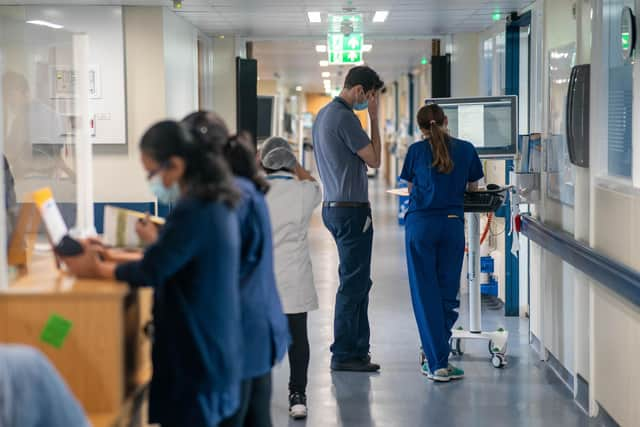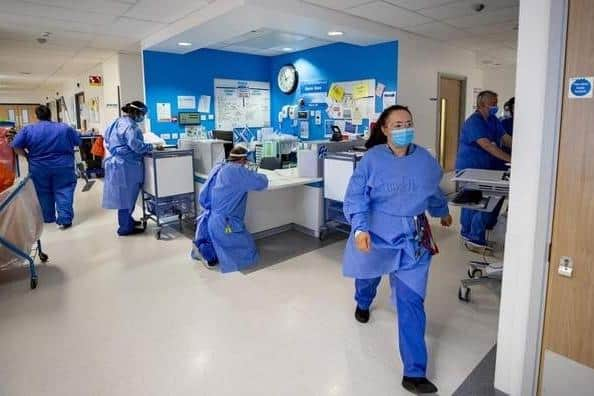NHS: Could one Scottish health board hold the key to fixing the NHS's A&E crisis?
The first - and currently only - health board to hit the Scottish Government’s A&E waiting times target has lifted the lid on their innovations which could save Scotland’s crumbling A&E system.
Scotland’s A&E departments have struggled to recover from the coronavirus pandemic, as a backlog of surgeries, a crisis in social care causing delayed discharges and an ageing, more severely ill population have contributed to hospitals reaching breaking point.
Advertisement
Hide AdAdvertisement
Hide AdAn A&E doctor recently revealed to The Scotsman that 24 hour waits are “no longer unusual”, with patients being left waiting outside in ambulances and sick people dumped in corridors “with no real nursing or medical care” while they wait to be seen - all before the winter commences.


The Scottish Government aims to ensure 95 per cent of patients presenting at an A&E department are seen within four hours, but currently just 63.2 per cent are seen within that timeframe.
Only one mainland health board has managed to buck the trend: NHS Tayside. The Dundee-headquartered health board has consistently topped the leader of best performing A&Es on wait times, and on Tuesday will be confirmed as the only health board to hit the Scottish Government’s four hour waiting time target.
“We consider the four-hour target as the ‘emergency access standard’,” said Dr Monica Doyle, clinical director of unscheduled care, “and we have really bought into that across the whole system.”
There are three major themes running across NHS Tayside’s model: the filtering of patients to the correct departments or services, a ‘professional-to-professional phoneline’ which connects medical professionals of various disciplines instantly, a cross-network philosophy that has every department “pulling in one direction”.


The filtering of patients is a key tenet of the Tayside system, but has taken decades to bed in.
While in other health boards, a patient needing treatment may go to A&E for diagnosis, in Tayside, patients who present at emergency departments with minor illness or injury are assessed early by a senior doctor or nurse to ensure that they do not require emergency care before they are redirected to the most appropriate service.
If a patient is critically ill but does not need resuscitation, ambulance crews are empowered to speak to an Acute Medical Unit (AMU) - a unit which specialises in medical problems that require urgent attention, but do not require admission to an intensive care unit - and to on-call doctors who can admit them without the need to go to A&E.
Advertisement
Hide AdAdvertisement
Hide AdThe system is designed to avoid duplication of work, such as in a traditional hospital system, where patients are assessed individually by each department each time they are transferred.
Patients in Tayside are also much more aware of where they need to go for specific ailments, said Dr Andrew Kinnon, the clinical lead for emergency medicine at NHS Tayside.
“There's been a long history of redirection and signposting for 20 years, and the Scottish Government formally made that a guideline two to three years ago, and a lot of that was based on the work in Dundee,” said Dr Kinnon.
“I think culturally, over that 20 years, the public has developed an awareness that if there was something that wasn't deemed to be an emergency or was more chronic, then they would not just automatically be be seen in an emergency department they would instead be assessed by a senior clinician, but then they may be asked to go and see a more appropriate health care provider whether that’s an out-of-hours GP or their own GP”.
The second pillar of Tayside’s system is the professional-to-professional phoneline, or ‘prof-to-prof’ in the health board’s internal jargon.
“We have a consultant who holds a phone that's available for prof-to-prof advice for colleagues in primary care and the ambulance service, from eight in the morning till ten o'clock at night,” said Dr Kinnon.
The Tayside system has not been without critics, however, as during the last two decades concerns have been raised regarding the redirecting of patients to other departments.
In 2015, Scotland’s chief medical officer, Dr Catherine Calderood, visited Dundee's Ninewells Hospital after whistleblowers claimed that surgeons are prevented from seeing A&E patients to speed up waiting times.
Advertisement
Hide AdAdvertisement
Hide AdA doctor at Ninewells Hospital told BBC Scotland at the time that surgical teams were barred from seeing patients to manipulate figures, and a second whistleblower said the system was putting patients at risk. However, Dr Calderwood found “no evidence” to support the whistleblowers’ claims, but did criticise communication between A&E and other teams.
Recently, an NHS Tayside GP said: “Tayside have one of the shortest emergency department waiting times, but that’s because they refuse to see anyone unless they need resus or are injured that day.
“The rest goes direct to the Acute Medical Unit, the Acute Surgical Receiving Unit, paediatrics or to their GP or out-of-hours GP.
“The build up and delays sit in the Acute Medical Unit instead most of the time so [they are considered] ‘admitted’.”
In response, Dr Doyle said: “Probably going back five or ten years perhaps that quote was right, the ACU was maybe just an emergency department.
“We used to have people sitting in corridors, but we tend not to have that anymore because what we've got is the whole system has been brought in.
“Acute medicine was always brought into the emergency department, but now we've got the rest of the system so we can ensure that there is flow through the whole hospital system.”
Dr Doyle added that Tayside tries to “get the patient’s journey right from the very first step”.
Advertisement
Hide AdAdvertisement
Hide Ad“We have various consultants holding the prof-to-prof phone to give advice and accept patients to the most appropriate place,” said Dr Doyle.
“And I think as a patient, the last thing you want is to have to go to Ed if you don't have to go there.”
Other health boards have visited Tayside for learning, and Tayside staff have returned the visits, sparking hope Scotland’s healthcare system may be able to innovate itself out of the current crisis it is experiencing in primary care.
The latest A&E figures, due to be released on Tuesday, will show that NHS Tayside has exceeded the Scottish Government’s four hour waiting target - the first health board to do so since January 2022, when Tayside was also the last health board to hit the target.
Other than Tayside, the last mainland health boards to hit the 95 per cent target were NHS Highland, in October 2020, and Dumfries and Galloway, in November 2020.
Comments
Want to join the conversation? Please or to comment on this article.